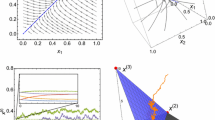Abstract
We consider a population consisting of N particles each of which some type is ascribed to. All particles die at the integer time moments and produce a random amount of particles of the same type as the parent. Moreover, the population retains its size N and the random vectors defining the number of offsprings of each particle have exchangeable distributions. We obtain several upper bounds for the expectation of the variable equal to the number of the generation when all particles in the population become single-type or almost single-type. Here we fix an arbitrary initial configuration of particles according to types.
Similar content being viewed by others
References
Cannings R., “The latent roots of certain Markov chains arising in genetics: a new approach. I: Haploid models,” Adv. Appl. Probab., 6, 260–294 (1974).
Cannings R., “The latent roots of certain Markov chains arising in genetics: a new approach. II: Further haploid models,” Adv. Appl. Probab., 7, 264–282 (1975).
Durrett R., Probability Models for DNA Sequence Evolution, Springer-Verlag, Berlin (2002).
Haccou P., Jagers P., and Vatutin V. A., Branching Processes: Variation, Growth, and Extinction of Populations, Cambridge Univ. Press, Cambridge; New York (2004).
Zubkov A. M., “Limit distributions of the distance to the nearest common ancestor,” Theory Probab. Appl., 20, No. 3, 602–612 (1975).
Vatutin V. A., “Distance to the nearest common ancestor in Bellman-Harris branching processes,” Math. Notes, 25, 378–387 (1979).
Kingman J. F. C., “On the genealogy of large population,” J. Appl. Probab. Spec. A, 19, 27–43 (1982).
Kingman J. F. C., “The coalescence,” Stochastic Process. Appl., 13, 235–248 (1982).
Möhle M., “The time back to the most recent common ancestor in exchangeable population models,” Adv. Appl. Probab., 36, 78–97 (2004).
Klokov S. A. and Topchii V. A., “On the time of supplanting all particles by particles of one type in a fixed size population,” Siberian Adv. Math., 16, No. 2, 93–107 (2006).
Klokov S. A. and Topchii V. A., “Estimation for the mean time of achieving homogeneity in populations of fixed size,” Optimization, Control, and Intellect, 1–10 (2006).
Schweinsberg J., “Coalescent processes obtained from supercritical Galton-Watson processes,” Stochastic Process. Appl., 106, No. 1, 107–139 (2003).
Korolyuk V. S., Portenko N. I., Skorokhod A. V., and Turbin A. F., Handbook on Probability and Mathematical Statistics [in Russian], Nauka, Moscow (1985).
Meyn S. P. and Tweedie R. L., Markov Chains and Stochastic Stability, Springer-Verlag, Berlin (1993).
Author information
Authors and Affiliations
Additional information
Original Russian Text Copyright © 2006 Klokov S. A. and Topchii V. A.
__________
Translated from Sibirskiĭ Matematicheskiĭ Zhurnal, Vol. 47, No. 6, pp. 1275–1288, November–December, 2006.
Rights and permissions
About this article
Cite this article
Klokov, S.A., Topchii, V.A. Mean fixation time estimates in constant size populations. Sib Math J 47, 1042–1053 (2006). https://doi.org/10.1007/s11202-006-0113-7
Received:
Issue Date:
DOI: https://doi.org/10.1007/s11202-006-0113-7




